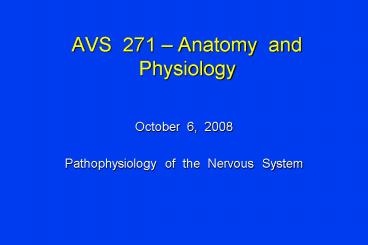AVS 271 Anatomy and Physiology PowerPoint PPT Presentation
1 / 21
Title: AVS 271 Anatomy and Physiology
1
AVS 271 Anatomy and Physiology
- October 6, 2008
- Pathophysiology of the Nervous System
2
Tetanus (lock jaw)
- Caused by the gram positive anaerobic
bacterium Clostridium tetani - Produces a potent exotoxin
- Present in soil
- Organism grows in dirty / necrotic anaerobic
wounds - Especially puncture wounds
- Tail docking / castration wounds
- All species of domestic animals are
susceptible - Horses are exquisitely sensitive
3
Pathogenesis
- The exotoxin is a neuro toxin that blocks
neurotransmitter release of pre synaptic
inhibitory interneurons that influence
efferent somatic (motor) neurons
4
Clinical Signs
- Evident two weeks to one month from
bacterial inoculation - Loss of inhibition of somatic (motor)
neurons leads to muscle spasms and hyper
tonia - Masseter muscle most commonly affected,
along with other facial muscles - Lock jaw
- Prolapse of the third eyelid, flared
nostrils - Progresses to the muscles of the neck,
trunk and limbs - Sawhorse stance, difficulty walking
- Death due to respiratory failure
5
Clinical Signs
6
Treatment
- Provide muscle relaxation
- Sedation and muscle relaxants
- Provide good footing / bedding
- Eliminate the inciting infection
- Neutralize unbound toxin
- Anti toxin (anti serum)
- Supportive care
- Maintain hydration and nutrition
7
Prognosis
- 50 to 80 mortality
8
Prevention
- Vaccination with tetanus toxoid (inactivated
toxin)
9
Botulism
- Caused by the gram positive anaerobic
bacterium Clostridium botulinum - Produces several potent exotoxins
- Present in soil, decaying vegetable matter
(bad silage) or animal carcasses
(geographic distribution) - All species of domestic animals are
susceptible - Horses more susceptible than ruminants
- Three forms of the disease
- Forage poisoning (ingestion of pre formed
toxin) - Toxico infectious botulism
- Wound botulism
10
Pathogenesis
- Toxins block acetylcholine release at
peripheral synapses (esp. somatic motor
neurons) - Interferes with exocytosis of acetylcholine
vesicles, preventing release of the
neurotransmitter
11
Clinical Signs
- Evident within 1 to 7 days from ingestion
/ formation of the toxin - Hypotonia of all skeletal muscles
- Progressive generalized weakness and ataxia
(loss of muscle coordination) - Inability to eat, protrusion of the tongue,
drooling - Horses show weakness and trembling, which
subside after a period of recumbency
(laying down) and then reappear - Shaker foal syndrome
12
Treatment
- Supportive care
- Maintain hydration and nutrition
- Antibiotic therapy
- For toxico infectious or wound form of
the disease - Anti toxin (anti serum)
13
Prognosis
- Slow onset of clinical signs is associated
with a better prognosis than with rapid
onset of clinical signs
14
Prevention
- Vaccination with botulism toxoid (inactivated
toxin) - Generally only used in areas where the
disease has been a problem - E.g., Kentucky and other areas of the
Eastern United States
15
Intervertebral Disk Disease(herniated disk)
16
Pathogenesis
- Physical bulging and / or extrusion
(herniation) of interveterbral disk material
into the spinal canal that compresses and /
or damages the spinal cord
17
Clinical Signs
- Pain
- Crying, loss of appetite, reluctance to
move - Ataxia
- Incoordination of muscle movement / control
- Paresis
- Muscle weakness
- Paralysis
- Urinary and / or fecal incontinence
18
Clinical Signs
19
Diagnosis
- Signalment and history
- Breed e.g., Dachshund
- Physical examination
- Neural function testing
- Radiography
20
Treatment
- Cage rest
- Anti inflammatory and / or analgesic
medication - NSAIDs, cortisone, muscle relaxants
- Surgery
- Relieve pressure on spinal cord
21
(No Transcript)

